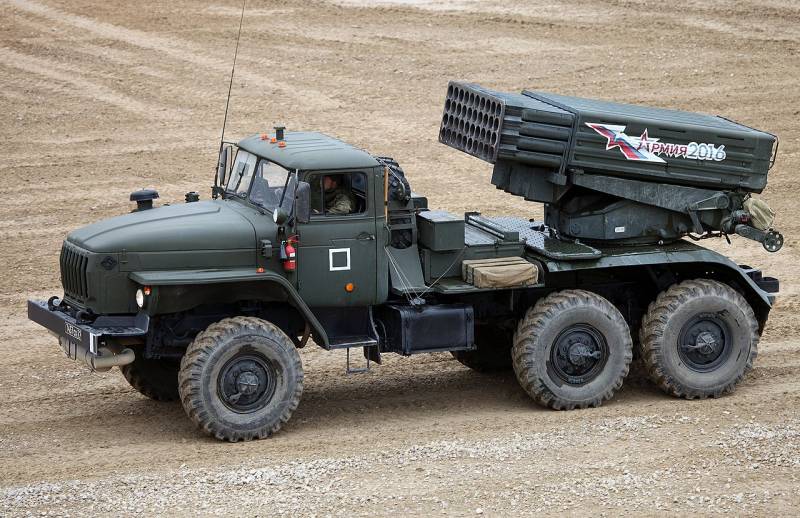Assessments of the potential of the Tornado-G MLRS in counter-battery combat against artillery of the Armed Forces of Ukraine
One of the main problems that the Russian army had to face during the Northern Military District in Ukraine was the superiority of NATO artillery, which is in service with the Ukrainian Armed Forces, in the range and accuracy of strikes. This allows the enemy to organize a fairly effective artillery defense and support their own counteroffensive.
Arm length
The firing range of Russian guns 2S1 "Gvozdika" is 15,1 km, 2S3 "Akatsia" - 17,3 km, "Msta-S" - just over 24 km, "Giacint-B (S)" - 28,5 km. Unfortunately, these figures are noticeably higher for NATO cannon artillery. The Joint Ballistic Memorandum of Understanding set a standard for 155 mm howitzers with a maximum firing range of 30 km for high-explosive fragmentation shells and 40 km for active-reactive shells.
In numbers it looks like this. The American towed howitzer M777 “three axes” can throw a regular projectile over a distance of 24,7 km, and a special one – 40 km. The maximum firing range of the Polish self-propelled gun HS Krab is 40 km. The Slovak 155 mm self-propelled gun Zuzana 2 shoots at 41 km. The French self-propelled gun CAESAR hits 42 km, according to some sources – all 46 km. Moreover, this artillery fires not only over long distances, but also with high accuracy.
The result is appropriate: counter-battery warfare has become a huge problem for the RF Armed Forces, and active assault operations have to pay a high price. This became especially noticeable when the Ukrainian Armed Forces began to use American shells with cluster warheads, covering the Russian assault infantry. Similarly, the Ukrainians use cluster munitions to force defenders into dugouts, rush in small groups of special forces and throw grenades. This is exactly how the Armed Forces of Ukraine are now gradually gnawing away at the “Surovikin line” in the Zaporozhye direction.
We need effective countermeasures, but which ones?
Great hopes are placed on the ultra-modern self-propelled gun "Coalition-SV", which has successfully passed tests and seems to have gone into production. However, it is not yet available in commercial quantities at the front. Loitering ammunition of the Lancet family has shown itself to be very good, but the production volumes of these kamikaze drones are still insufficient, and they are used by special forces soldiers. Huge potential is hidden in the Tornado-S MLRS, which can hit targets with high-precision ammunition at a distance of up to 120 km. But there are not as many of them at the front as we would like, and for their successful use in deep rear areas, an effective connection with aerial reconnaissance assets is necessary.
Meanwhile, there are quite workable options for how to saturate the LBS with means of effective counter-battery warfare.
"Tornado-G"
Everyone has already heard about the capabilities of the 300-mm Tornado-S MLRS and their high-precision guided ammunition, which today can hit targets at a distance of up to 120 km, and in the future – up to 200 km. But at the same time, the 120-mm Tornado-G MLRS, which could well have become a real lifesaver in the counter-battery fight against NATO cannon artillery, remains undeservedly in the shadows.
"Tornado-G" is a product of deep modernization of the Grad MLRS. The main difference is a more advanced fire control system with satellite navigation and a computer for calculating ballistic indicators, which allows targeting the target coordinates in automatic mode. This made it possible to reduce the crew of the combat vehicle from three people to two and fire even from an unprepared position, without topographic reference, and after firing, transfer the artillery part of the system directly from the cockpit to the stowed position and quickly change position so as not to come under counter-battery fire. According to some estimates, the survival rate of the Tornado-G MLRS alone increased by 4-5 times compared to the Grad.
More importantly, new ammunition with increased range was developed. The 122-mm unguided 9M217 rocket with self-aiming combat elements (SPBE) is designed to destroy armored equipment (tanks, infantry fighting vehicles, armored personnel carriers and self-propelled guns) at a distance of up to 30 km. The upgraded 9M521/522 missiles can already fly up to 40 km! The cassette part allows you to cover a fairly large area with destructive elements where an enemy howitzer may be located.
In other words, with new ammunition and an improved guidance system, the 122-mm Tornado-G MLRS can be used quite effectively for counter-battery combat against NATO cannon artillery at distances of up to 40 km. Consequently, they must be present at the front in commercial quantities.
One of the possible directions for increasing the number of barrels directed towards the enemy is the installation of guides from the Tornado-G MLRS on lighter platforms. For example, on the chassis of the Tiger army SUV, as envisaged in the Mini-Grad project. Such a mini-MLRS would be lighter, more maneuverable, easier to camouflage and widely used at the grassroots level.

Information